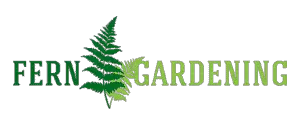The success of any pot plant depends on two big factors: appropriate watering, and choosing the best potting compost mix for the plant. Ferns have different needs compared to other popular pot plants, and so it’s not obvious what the best choice would be for a potting mix that helps your fern thrive.
The best potting mix for ferns is a medium density loam-based compost, with coarse materials added for drainage, but limited fertilizer. A general multipurpose commercial mix is a good base, supplemented with some grit or perlite to aid drainage. This general mix will work very well for most fern varieties, but some specialist ferns will need adjustments for pH, moisture retention, and nutrient density.
The overall goal when choosing a potting mix is to establish a good root system that will get the plant adapted to life in a container. The best way to achieve this is to try and reproduce the soil conditions that predominate in the fern’s natural environment.
Generally speaking, ferns grow most commonly in woodland or in sheltered spots beside rivers and streams. They have shallow root systems, and so grow in soil that is dense in organic material (such as rotting leaf litter and pine needles), well drained, and not too rich in minerals.
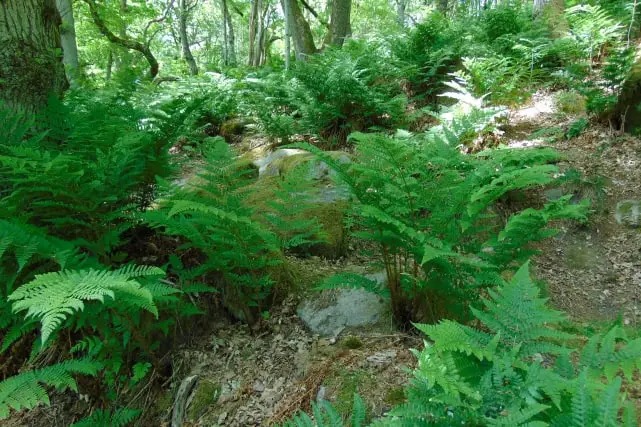
The ideal potting mix will therefore have similar composition. To decide on how best to achieve this in practice, it is important to understand what goes into a typical potting compost, and what the different elements do in terms of providing for the plant’s needs.
What is potting compost made from?
The core element of most potting mixes is loam. This is the soil base, and is composed of clay, sand and humus mixed at different fractions. Clay and sand are obvious, but “humus” possibly needs a bit more explanation. This is the rotted down organic material that is nutrient rich and moisture retaining. In the natural habitat, this would mostly be the decaying leaves, needles and undergrowth plants that build up on the forest floor. For potting, the dense, crumbly, black material that comes from well-composted garden waste or manure would work just as well.
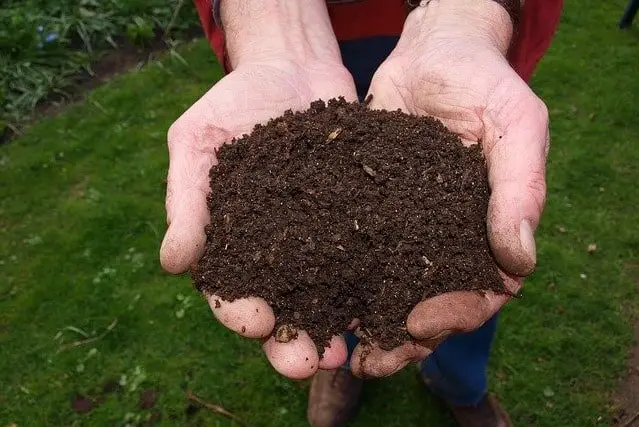
The next key element of a potting mix is peat moss or an alternative. Traditionally, this is the decomposing remains of sphagnum moss that is harvested from peat bogs, and provides increased aeration and water retention to the loam. Nowadays, there is understandable concern about the threat to the natural environment due to peat harvesting (as it takes thousands of years for peat beds to develop), and so good alternatives have been developed. Coir (coconut fibers), wood fiber or composted bark are suitable replacements for moss, and do not have the same negative impact of exhausting a limited natural resource.
A third component is some sort of physical conditioner that does not decay or break down, and so improves the drainage of the overall mix. Coarse sand, grit, pumice and perlite (volcanic glass) have all been used to prevent waterlogging of compost mixes. This component is of special importance for ferns that cannot tolerate sodden roots.
Finally, many potting mixes are supplemented with fertilizer. This provides the nutrients and minerals needed by the plant for root and foliage growth. The key chemicals are nitrogen, potassium and phosphate, but many other trace minerals will also be present. The balance of these nutrients is key to healthy growth. Both too little and too much can harm the plant.
Homemade potting compost
It is possible to make a good, reliable potting mix at home. Many experienced gardeners take pride in their own special recipes, refined through years of experimentation (or, at least, trial and error). A straightforward way to start with a fern friendly mix is to use a simple combination of soil, humus, and grit or coarse sand. This can be supplemented with a modest amount of natural organic fertilizer such as seaweed or bone meal – although this is probably not necessary.
The soil and humus mix is your loam, and so if you have a heavy clay soil in the garden, add more sand to make a more fine and crumbly mix. Alternatively, good quality top soil can be bought, or made at home by composting turf.
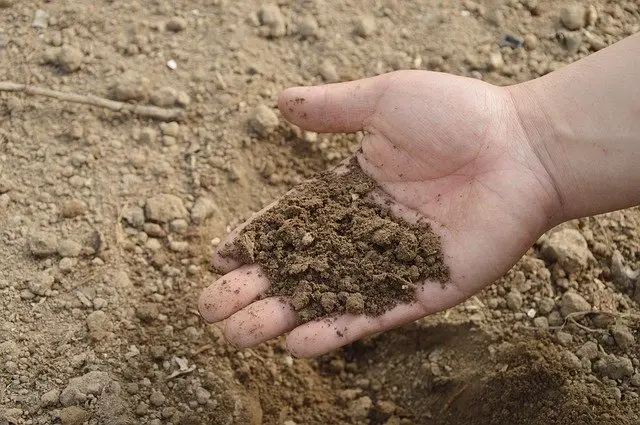
Humus is best prepared from leaf mold or composted bark, as this will be ideal for ferns, but ordinary garden and kitchen waste compost is fine as an alternative. The best mix is one part soil, one part humus and one part grit. Mix well, and sprinkle in a small amount of fertilizer if desired. This simple composition should give good results.
A downside to using homemade potting mix is the risk that weed seeds, fungus, or pests may get carried over into your pots from the soil or humus. It is possible to sterilize (or pasteurize) sieved loam with a microwave, but this needs some care and experience. The alternative is to buy a pre-prepared commercial mix.
Standard commercial mixes
There are a wide array of commercial composts that have been optimized for different growing conditions. The basic components are the same as above, but the relative amounts of loam, peat, conditioner and fertilizer varies. There are mixes specially formulated for growing seeds, cuttings, for re-potting mature plants, and for particular needs like ericaceous (acid) soils.
Popular brands include Miracle-Gro, Kellogg and Espoma, but a wide range of manufacturers are out there competing for customers. In the UK, the John Innes formulations are popular – standardized mixes that many different manufacturers produce for specific uses. This array of choices can be confusing to the new gardener, and no specific “fern mix” exists (at least in most garden centers and home improvement stores), to make the choice easier. Fortunately, ferns love the simple, standard middle-of-the-road multipurpose mix.
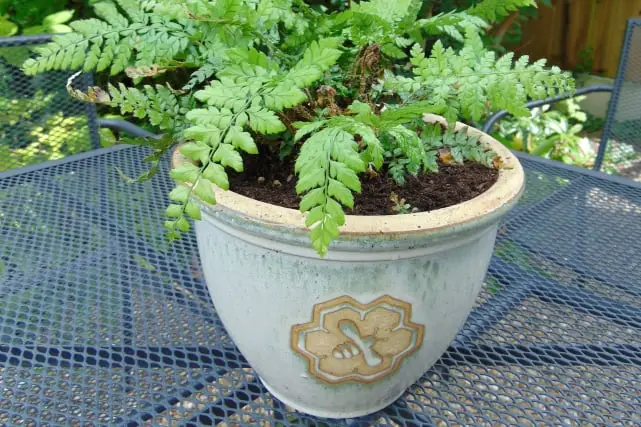
All of the common brands market these “all purpose” composts, and all that is needed for potted ferns to thrive is to add a little grit, sand or perlite to improve drainage.
Some exceptions
Finally, it is worth mentioning a couple of exceptions to these general rules. Typical multipurpose composts are in the pH 6-7 range (slightly acidic to neutral). This may not be suitable for some ferns, but adjustments can be made to favor acid or alkaline conditions.
The ever-popular Boston fern prefers acidic soil, and so the mix can be supplemented with sulfur to decrease pH and make the mix more acid.

Boston fern
- Nephrolepis exaltata
- Evergreen
- Partial shade
- Height: up to 1 m
- Soil: acid or neutral. Moist, well-drained.
Maidenhair ferns prefer alkaline soil, and so the mix should be supplemented with lime to increase pH and make it less acid.
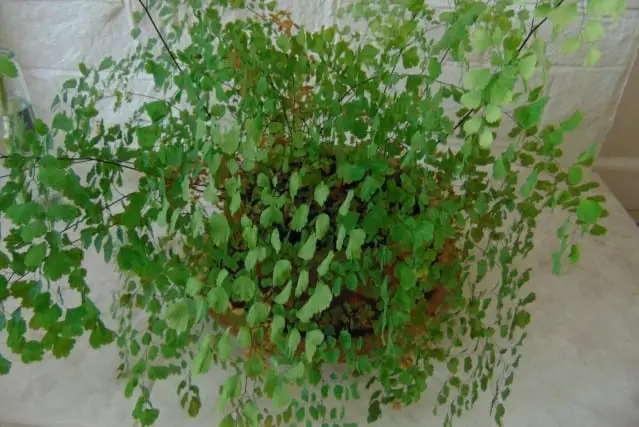
Maidenhair fern
- Adiantum raddianum
- Evergreen
- Partial shade
- Height: up to 0.5 m
- Soil: neutral or alkaline. Moist, well-drained.
Adjustments to soil pH can be slow, as they depend in part on bacterial processes, rather than simple chemical reactions. It may be simpler to buy a specialist commercial mix in these cases that has been formulated to the ideal acidity.
Ferns are generally quite flexible about the composition of the potting mix, with a standard multipurpose compost being suitable in most cases. The most important factor is the Goldilocks balance between moisture retention and drainage. Crack that, and your ferns are bound to prosper.
